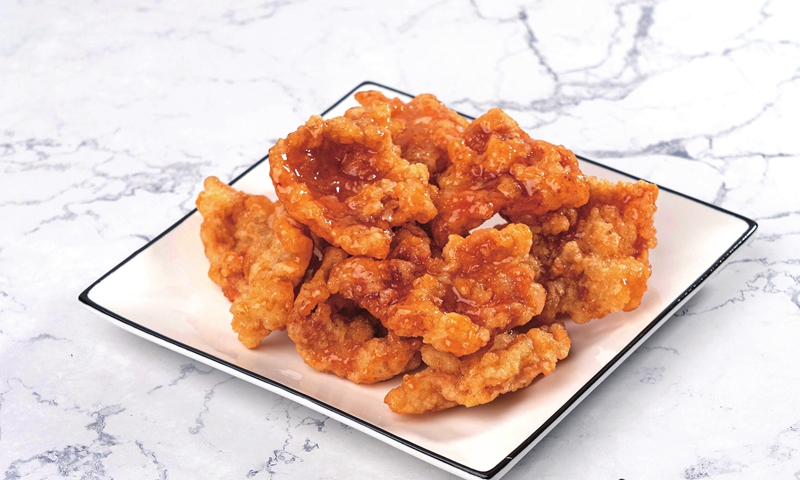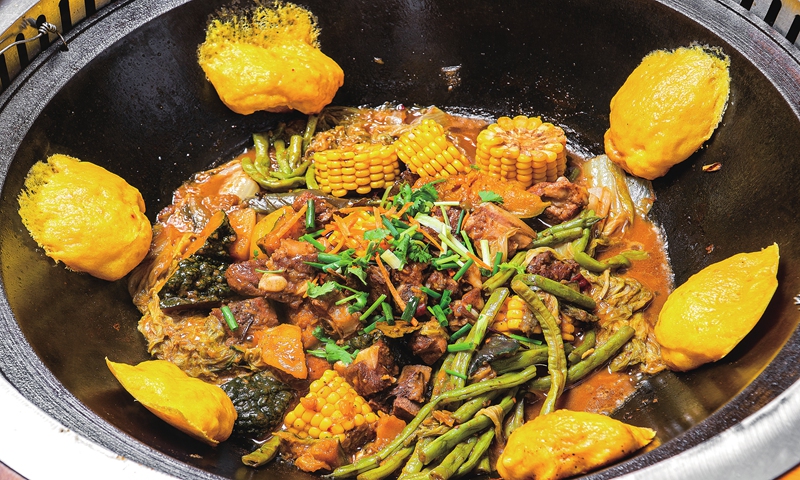ARTS / CULTURE & LEISURE
Exploring Northeast China’s culinary delights and culture

Guobaorou Photo: VCG
In late June, the World Guobaorou Contest was held in the city of Jilin, Northeast China's Jilin Province, attracting hundreds of domestic and foreign participants and helping promote Northeast China's culinary renaissance.
Guobaorou, or fried pork in scoop in Chinese, is a crispy pork dish characterized by a sweet and sour flavor, a classic dish from China's northeastern region. As the aroma of Guobaorou lingered on after the competition, news of Jilin's proposal to establish a "Guobaorou Office" further expanded the dish's popularity.
Despite debates over its precise origin within Northeast China, the dish indisputably holds a prominent position as a regional delicacy.
Northeast China has long been renowned for its distinctive regional cuisine and flavorful ingredients. Beyond Guobaorou, the region also boasts a repertoire of iconic dishes such as iron pot stew, stir-fried eggplant, potato and pepper, and potato vermicelli, each offering unique flavors and textures.
Creative recipe
Guobaorou originated from Emperor Guangxu's reign (1871-1908) of the Qing Dynasty (1844-1911) under the stewardship of Chef Zheng Xingwen at the Harbin governor's office. To cater to the tastes of foreign guests, the originally savory dish pork strips was modified into a sweet and sour dish and it later became known as Guobaorou.
The dish involves marinating slices of pork or beef tenderloin, coating them with batter, deep-frying to a golden hue, then stir-frying with additional ingredients and a sweet-and-sour sauce. The finished dish features a golden color, crispy exterior, tender interior, and a delightful balance of sweet and sour flavors.
The hashtag referring to the World Guobaorou Contest went viral online and has been viewed over 10 million times on Sina Weibo, China's X-like platform. Featuring 286 participants from across China and other countries such as India, South Korea and Singapore, the contest showcased both traditional tastes on Guobaorou and more creative flavors.
The participants had to finish a test in the preliminary round, in which they must complete the dish in its traditional form, and those who entered the final had the chance to wield their imagination to create an innovative recipe for the dish. After two days of contest, 149 participants received commendation for their culinary creativity.
"In a sense, Guobaorou serves as a cultural symbol. Local authorities aim to gain visibility through online promotion and drive its integration with cultural tourism or other sectors," remarked Song Yangyang, vice dean of the Institute of Creative Industry Technology at the Renmin University of China.
Unlike standardized geographical indicators such as the West Lake Longjing Tea, Guobaorou is not yet "a standardized product or concept." Therefore, the competition primarily aims to "go viral," focusing on how to integrate it with local cultural and tourism resources, he said.

Iron pot stew Photo: VCG
Robust flavors
Northeastern Chinese cuisine is celebrated for its robust flavors and hearty dishes. Influenced by the region's climate and agricultural practices, it features staple ingredients like pork, lamb, and pickled vegetables.
The cuisine reflects a diverse culinary influence, incorporating elements of China's ethnic Mongolian, Russian, and Korean traditions due to the region's proximity to ethnic minority areas.
Commonly featured are hearty stews like iron pot stew, or tieguodun in Chinese, where meats and vegetables simmer to enhance flavors.
A time-honored tradition of Northeast China is simmering in iron pots - a stew that warms hearts and palates especially in the cold winters of the region. This beloved dish, known for its slow-cooked goodness and home-style flavors, typically features tender chunks of pork or beef, paired with potatoes, carrots, and onions. A medley of aromatics like ginger, spring onions, and cooking wine adds depth to the brew.
Sometimes, flatbreads are placed alongside the pot to absorb the broth's essence, adding layers of texture and taste. As the ingredients mingle in the iron pot, the slow cooking process coaxes out rich flavors, yielding tender meat and a savory broth that's nothing short of comfort in a bowl.
Stir-fried eggplant, potato and pepper, or disanxian in Chinese, is renowned for its light flavor and vibrant colors. The dish mainly consists of potatoes, eggplants, and green peppers, cut into chunks or slices, and then stir-fried to a golden brown.
Typically seasoned with simple ingredients like salt and soy sauce, disanxian stands out for showcasing the distinct textures and colors of each vegetable while also offering a nutritionally balanced vegetarian meal.
Dalapi is another well-known traditional dish from Northeast China, primarily featuring broad, translucent noodles made from bean starch, known for their chewy and elastic quality. Dalapi is often garnished with cilantro and sometimes topped with thinly sliced meat or scrambled eggs to add protein. The noodles are typically served cold, making it a popular dish, especially in the hot summer months. This dish not only highlights the ingenuity and resourcefulness of northeastern Chinese cuisine, but also reflects the region's preference for simple yet flavorful meals.
Northeast China celebrates its culinary traditions and innovations through dishes that are both culinary delights and cultural symbols, reflecting the region's identity and cuisine culture. Whether enjoyed at home, in local eateries, or celebrated at international competitions, northeastern cuisine maintains a prominent position in the Chinese culinary landscape, inviting all to savor its flavors and stories.



